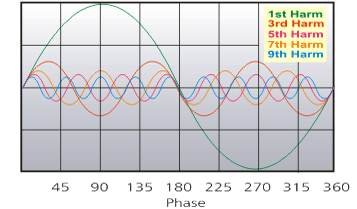Active Harmonic Filtration
(AHF)
Introduction
A harmonic filter is used to eliminate the harmonic distortion caused by appliances on a network and inputted from the 'grid'. Harmonics are voltages and currents that are continuing multiples of the fundamental frequency, commonly 50Hz.
Harmonic Currents - This being power that cannot be used, taking up electrical capacity and in large amounts, these can damage equipment and reduce lifespans of equipment.
Internals of a Harmonic Filter
Internally the components are multiples of capacitors, inductors and resistors, these are the majority of the components which have one job to channel harmonic currents to earth
The Cause and the Effect
Non-linear loads are what cause harmonic distortion, these types of loads use current in a pulsed manner and feed currents back into the wiring.
Examples of non-linear loads are:
-
Computers
-
Battery chargers
-
Lighting dimmer controls
-
Fluorescent lights
-
Welders
-
Electronic ballasts
-
Printers

The difference of the current waveform from the voltage waveform causes the following:
-
Voltage distortion
-
Large neutral currents
-
Computer crashes
-
Motors overheating
-
Processor control issues
Function of Harmonic Filters
Such filters perform the following tasks:
-
Reduction of neutral currents & neutral protection
-
Reduces transformer loading and increases system capacity
-
Minimises impact on distribution transformers
-
Reduces local neutral to ground voltage
-
Lowers peak phase current/average phase current
-
Decreases system losses
-
Improves power factor on non-linear loads
-
Reduces total harmonic distortion
-
Improves voltage & current balance
Overall such implementation protects electrical systems by enhancing system protection.

What's to specify
Essentially you have two options
-
Allow a breaker for future Active Harmonic Filtration
-
Allow a breaker and the Active Harmonic Filtration Installed
The first option is most viable and common practice as the exacts are strongly unknown until final completion.
AHF Guideline Install
This is very apparent to your scheme, there isn't a guide or a rule of thumb, each install will have its own elements that will effect the end product of AHF. The only way is the seek an expert as the maths is extremely complicated, even then, they will probably advise, wait to complete a study (I hear manufacturers are doing it for free now).
Connection
Connection and therefore the install is simple, the filtration equipment is connected by a 3/4 pole breaker directly coupling the equipment onto the bus when closed. The controller or PLC would at the very most require a three phase supply and neutral for power and monitoring, and also a single phase CT on each phase, L1, L2 & L3 connected at the switchboard incoming supply.
Location
Pretty much on the Main LV Switchboard, where the supply comes in, however, it is common to implement locally to equipment, also common to have AHF dotted around your network for particular areas or one for each building (for example) if supplying several, however again it's quite unique and we here would always seek expert advice.